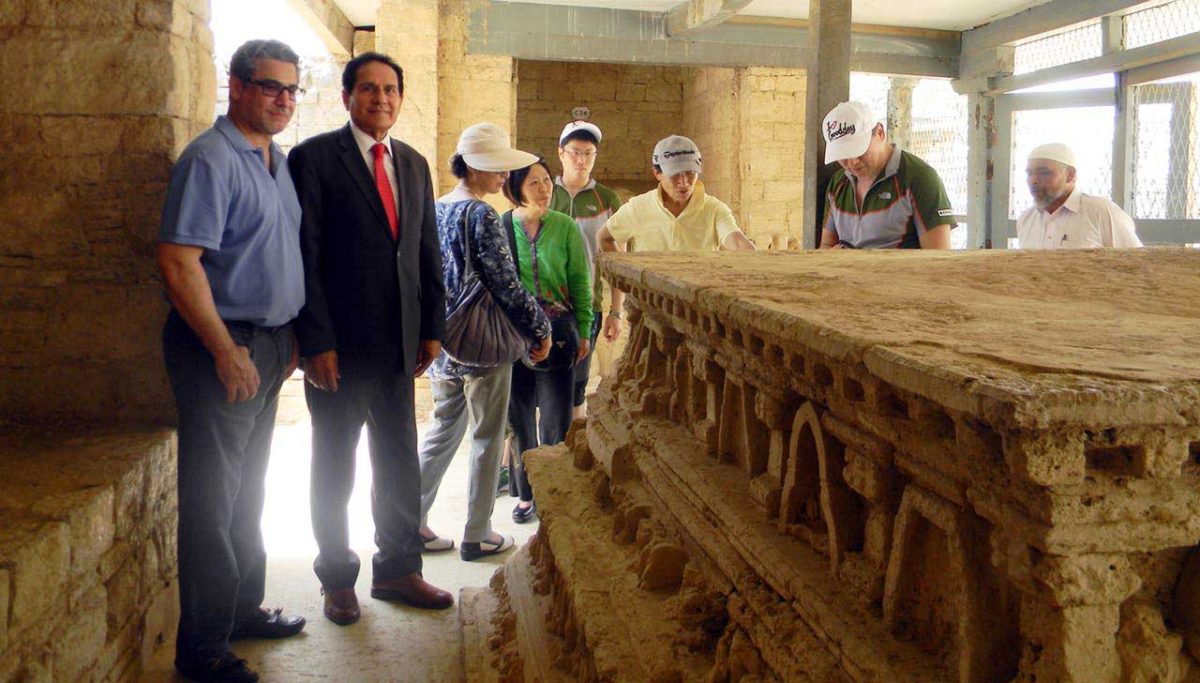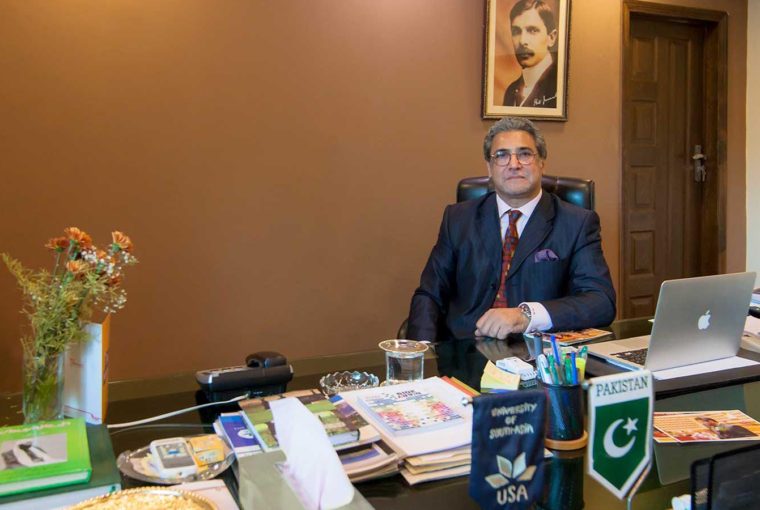The Gandhara Art and Culture Association is a non-profit organization working for the preservation and rehabilitation of Pakistan’s ancient Gandhara sites. Mian Imran Masood, its chairman, explains why Gandhara’s Buddhist legacy and ensuing principles of pluralism must be celebrated and safeguarded for future generations.
Lying at the crossroads of various cultural influences, the ancient land of Gandhara provides one of the finest examples of Pakistan’s multicultural heritage. Centered around the Peshawar Valley in Northern Pakistan and extending towards Afghanistan on one side and the Potohar Plateau in Punjab on the other, Gandhara flourished over centuries of rule by different dynasties, each leaving its unique mark on the land and its people, creating a melting pot of religious, cultural and artistic expression.
Conquering the region around the 4th century BCE, Alexander brought in Greco-Roman influences, while the Mauryan Empire that followed led to the spread of Buddhism. The Kushans, who came in from Central Asia, ushered in an era of economic prosperity by strengthening trade links along the Silk Road. Gandhara thus became an affluent center for art and culture as well as for spiritual learning, with Buddhist influences merging with Indian, Greek, Roman and Central Asian elements to create an entirely new school of art.
While the civilization eventually declined around the 9th century CE, Pakistan is dotted with rich remainders of Gandharan architecture and artifacts that tell the story of a golden age. Working diligently to preserve this unique heritage is the Gandhara Art and Culture Association, a non-profit organization that believes Gandhara’s Buddhist legacy must be safeguarded at all cost. DESTINATIONS recently met up with its chairman, Mian Imran Masood, to speak about the organization’s long-terms goals as well as the importance of ancient Gandhara and its principles of harmony and co-existence in the present age.
What is GACA’s main objective?
There is only one registered association working for the preservation of Gandhara heritage and that is Gandhara Art and Culture Association (GACA), which was formed in 1985. The main objective of the association is simple: we believe that Gandhara heritage is world heritage and it must be preserved and protected. People have the right to come and see it from around the world, especially Buddhists for whom this region is sacred.
Currently, the majority of the sites are in disarray, there are no safety measures in place, nor has there been any proper documentation of Gandhara sites spread wide across the country. We have partnered with the archeology department (which falls under the Ministry of Information and oversees all museums) as well as private universities to work towards the rehabilitation and research of Gandhara sites.

Taxila, one of the main centers for Buddhist learning, was once home to a great university and GACA has plans to re-establish an educational institution in the city. Please elaborate on this academic objective.
The ancient university of Taxila was one of the most renowned universities of its time, where both religious and secular subjects were taught. Some of the greatest names in history graduated from Taxila University, including Chandra Gupta Maurya, the founder of the Mauryan Empire. These days, Gandhara is studied in depth by PhD scholars from abroad, who came to Pakistan and take their research back with them. We believe that by reviving one of the oldest universities in the world at Taxila, Pakistan will become a leading name in Gandhara learning and research.
The Gandhara Art and Culture Association is working closely with the Koreans on many of its proposed projects; how has this collaboration come about?
Korea is mainly a Buddhist nation and has a keen interest in preserving Buddhist sites across the world. The remains of Gandhara hold a great significance for them, being some of the oldest surviving symbols of Buddhism. GACA’s Secretary General is a Korean researcher by the name of Esther Park, and she has connected us to Korea’s chief monk, who has visited Pakistan around 7 times in the last five years. During his last visit, we conducted a live prayer in Jaulian, Taxila, something which hadn’t occurred there in 1,500 years. We are now working to establish a joint programme for the Taxila University, as well as for restoration works on Gandhara sites, as Korean artisans possess the requisite skills needed to work on the architecture.

With the proposed visa-free Kartarpur Corridor between India and Pakistan to facilitate Sikh pilgrims on the cards, the current government’s interest in promoting religious tourism seems evident. Do you hope that Pakistan’s Gandhara sites will also receive similar attention?
In China, Japan and Korea alone, the Buddhist population exceeds 100 million. Given the spectacular Buddhist sites in Pakistan, which have no equivalent anywhere in the world, not even Nepal which is the birthplace of Buddha, the country’s potential for religious tourism is enormous. The Takht Bahi monastery, for example, is a mecca for Buddhists and I have met Koreans who would give anything to be able to access it freely. The Kartarpur agreement took 40, 50 years of commitment and hard work to finally materialize. The current government’s interest in promoting tourism fills us with optimism that the ignored phenomenon of Gandhara will also finally receive the attention it deserves. The PM’s office is our next destination.
What are some of the main challenges faced by the association in the pursuance of its objectives?
One of the major hurdles that we face is the mindset of the people, who consider statues and temples to be idolatrous and hence against our religion. Many of the finest relics and sites have been defaced, broken or simply stolen as there is a lack of respect. GACA is constantly running awareness campaigns to create an understanding amongst people of this precious heritage, which is in fact an ode to the concept of religious tolerance and multiculturalism.
Yet another challenge has been the lack of governmental support over the years. All Buddhist sites come under government jurisdiction and GACA being a private body cannot implement any protective measures without official consent. So far, the preservation of Gandhara site has not been on any government’s priority list; we have to struggle to be heard even for little things such as adding an information board or setting up a fence around a neglected area.
The ancient Buddhist monastery at Takht Bahi is listed as a UNESCO World Heritage Site; what is the special significance of this place?
Takht Bahi is a wonder – one of the most well preserved Buddhist remains to be found in this region and an architectural marvel dating back to 1st century CE. It has survived the ravages of time and invaders because of its unique position, arranged spectacularly on various hilltops, almost hidden from view. Its location, and that of other monasteries, reflects Buddhism’s deep connection with nature – pure, tranquil and almost otherworldly. But despite being on UNESCO’s list of heritage site, Takht Bahi is in need of major preservation and restoration works.
What has been the personal motivation behind your involvement in GACA, working towards the preservation of Gandhara?
I have always been a strong believer in interfaith harmony. As a minister, one of the main tasks that I undertook was to give Christian property, mainly schools and colleges, nationalized by the government in 1970, back to its rightful owners. The Christian community had been engaged in the struggle to get back what was rightfully theirs for decades and I felt that the issue had to be addressed in the interest of peaceful co-existence. Similarly, I believe that all religious sites should be respected and protected, especially if they are part of our unique heritage.

Did you Know
- Gandhara means “the land of fragrance.”
- The Gandhara region comprises the Peshawar valley, Mardan, Swat, Dir, Malakand, and Bajuaur agencies in Khyber Pakhtunkhwa, Taxila in Punjab, and up to Jalalabad in Afghanistan.
- The region was subject to Achaemenian Persia in the 6th and 5th centuries BCE and was conquered by Alexander the Great in the 4th century BCE. It was thereafter ruled by the Mauryan dynasty of India, under whom it became a center for the spread of Buddhism to Afghanistan and Central Asia. Gandhara was then successively ruled by Indo-Greeks, Shakas, Parthians, and Kushans. After its conquest by Mahmud of Ghazni in the 11th century CE, the region was held by various Muslim dynasties.
- The first and most fundamental of Buddhist architectural monuments, the Buddhist stupa serves as a marker for a sacred space, a symbolic representation of the Buddha’s burial mound.
Mapping Gandhara

Taxila
Taxila, the main center of Gandhara is over 3000 years old. During the year 2 BC, Buddhism was adopted as the state religion and Taxila became an important seat of culture, trade and learning. Three city-sites (Bhir Mound, Sirkap and Sirsukh) and numerous stupas and monasteries have been unearthed in this area, such as:
1. Bhir Mound
The city-site contains some of the oldest ruins of ancient Taxila, dating from the 4th century BCE. The ruins of Bhir Mound were excavated from 1913-1925 by Sir John Marshall.
2. Sirkap
The site of Sirkap bears witness to the city-building activity of the Indo-Greeks during their occupation of the Indian territory for close to two centuries, as well as their integration of other faiths, especially Buddhism.
3. Sirsukh
The city of Sirsukh was founded by the Kushan king Kanishka after 80 CE, and is the last of the great ancient cities of Taxila. It was defended by a fortified wall surrounding it.
4. Dharmarajika
A spectacular stupa and monastery said to have been founded by Asoka to house the relic of Buddha.
5. Jaulian
Jaulian was built by the Kushans in the 2nd century CE – around the same time as the nearby Mohra Muradu. Jaulian, along with the rest of ancient Taxila, was devastated in the 450s CE during the invasion of the White Huns, and later abandoned. Subsequent rulers persecuted the region’s Buddhists, and the site never recovered.
6. Mohra Moradu
The ancient monastery is located in a valley and offers a beautiful view of the surrounding mountains. The monks could meditate in the stillness at this place but were near enough to the city of Sirsukh to go for alms as it is only around 1.5 km away.
Peshawar
Peshawar valley closely rivals the Gandhara architecture of Taxila, with its main sites being:
1. Shahji Ki Dheri
Shaji-ki-Dheri is the site of an ancient stupa raised by King Kanishka in commemoration of his conversion to Buddhism, located about 6 kilometers from the city of Peshawar.
2. Takht Bahi
Takht-i-Bahi, is an Indo-Parthian archaeological site of an ancient Buddhist monastery in Mardan, Khyber-Pakhtunkhwa. The site is considered among the most imposing relics of Buddhism in all of Gandhara, and has been exceptionally well-preserved.
SWAT VALLEY
Buddhist tradition holds that the Buddha himself came to Swat during his last reincarnation as the Guatama Buddha and preached to the people here. While many sites remain unearthed, Buddhist relics have been found at the following places in the valley:
1. Butkara
The Butkara Stupa is an important Buddhist stupa near Mingora. It may have been built by the Mauryan emperor Asoka, but it is generally dated slightly later to the 2nd century BCE. The stupa was enlarged on five occasions during the following centuries, every time by building over, and encapsulating, the previous structure.
2. Barikot
Barikot, the ancient Bazira of Alexander the Great, is a city located at the south end of the Swat valley in Khyber Pakhtunkhwa. Near Bazira, a village of the Gandhara grave culture from the 7th to 8th century BC has been discovered.
3. Saidu Sharif
The Saidu Sharif Stupa is a sacred Buddhist area located near the city of Saidu Sharif, at the foot of the mountains that separate the river valley Saidu from that of the river Jambil, in the Swat District of Khyber Pakhtunkhwa. The sacred area consists of two terraces built on the slope of the hill, through a cut in the rock on the north side. Artificial terracing includes one stūpa, surrounded by smaller monuments, and a monastery.





